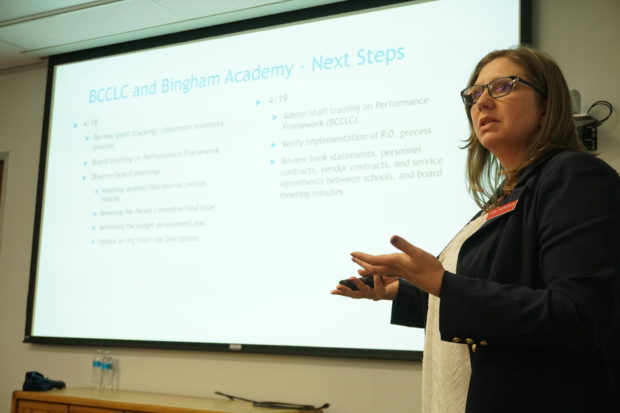Idaho charter schools are still a source of debate, but the debate has shifted over the years.
After more than 20 years of operation, schools are here to stay – a reality that largely takes traditional educators’ concerns about charters from being allowed to operate to effectively managing their growth.
Growth concerns arise as thousands of college students flocked to charters during the coronavirus pandemic.
Idaho law does not limit the number of charters operating within its boundaries. Some traditional educators see this as a threat in a state that divides K-12 funds according to a formula based on average student visits. As the charters grow, so does their share of the precious K-12 tax dollars.
The situation has caused districts to be pushed back, from marketing efforts to attract and retain students to legislative proposals aimed at limiting the number of student charter.
Meanwhile, Charter proponents say the expansion will bring competition and innovation to public education, and provide an inexpensive way to absorb the annual influx of students in one of the fastest growing nations in the country.
Worries about growth
Traditional school principals have been complaining about the loss of students and funding through charters for years.
In 2018 the Boise School District started an unusual marketing campaign to combat charter expansion. Caldwell and Payette counties last year Lobbying unsuccessful for a bill that limits the founding of a school to 25,000 residents of a school district. Similar proposals have surfaced unsuccessfully over the years.
Caldwell’s attempt to limit local charter seats was misunderstood as “anti-charter,” an “oversimplification of a complex process,” school board chair Marisela Pesina told EdNews.
“As a state, we need a dialogue about charter concentration in the communities,” she said, lamenting the approval of charter contracts for the Caldwell area that “offer double services that result in inefficient use of limited public resources.”
For Pesina, part of the problem lies in Idaho’s evolving charter laws. The state’s original charter legislation limited the number of charter schools allowed, but the law has changed since then.
Terry Ryan
Today Idaho is one of at least 20 states with no legal limit Charter growth, after the Education Commission of the Länder.
“As the law evolves, we see a need to talk about how the saturation of the chartered community is affecting their existing schools – traditional public and charter schools,” Pesina said.
Bluum, a statewide charter support group supported by JA and the Kathryn Albertson Family Foundation, is a leader in the Charter Expansion Efforts. But it’s not free for everyone, said CEO Terry Ryan.
Factors such as local population growth and the impact on district enrollments influence the decision to establish or expand a school.
“We’re trying to support schools where we think the need is greatest,” Ryan told EdNews.
For a state dealing with areas of rapid population growth, charters are also a benefit, not a burden, Ryan added. Most of the funds for charter facilities come from private donations and federal grants, no costly bond issues that can drive up local property taxes.
Monitoring charter growth
 Commission Director Jenn Thompson introduces during a 2018 meeting.
Commission Director Jenn Thompson introduces during a 2018 meeting.
Idaho law may allow charter expansion, but growth will be monitored, aaccording to Idaho Public Charter School Commission Director Jenn Thompson.
The “saturation” of the Charter becomes a concern for the Commission than about 15 percent of college students living in a district enroll in charter, Thompson told EdNews last year.
Most of the counties – including Caldwell and Boise – are not there yet. Nationwide, around 10 percent of students in Idaho attend charter schools.
Nevertheless, the number varies from district to district. The Blackfoot School District in East Idaho has the highest percentage of local students chartered, at nearly 21.5 percent, according to the latest commission report. A year earlier, the number had peaked at over 27 percent.
Here is a breakdown of the rate of return in the largest charter districts in the state:
- Boise: 8.9 percent
- Bonneville: 8.4 percent
- Nampa: 16.9 percent
- Pocatello chubbuck: 9.5 percent
- Coeur d’Alene: 5.8 percent
- Idaho Falls: 8.7 percent
Other districts with yield rates close to Thompson’s 15 percent threshold are Moscow (14.3 percent), Gooding (14 percent), and Fruitland (15.1 percent).
The following map shows where Idaho’s charter schools are – and are not. Click to enlarge or use the search function to find individual schools.
Disclosure: Bluum and Idaho Education News are both funded by JA and the Kathryn Albertson Family Foundation. The foundation has no influence on the editorial content of EdNews.
“More Choices, More Challenges” is an in-depth look at the robust drive to expand charter schools in Idaho. The series explores what the well-funded push will mean for Idaho families and leaders, and how the state is adjusting to growth. EdNews data analyst Randy Schrader provided data and information for this series. The series at a glance:
Monday
Tuesday
- The Idaho charters are still a matter of debate
Wednesday
- Charters are among Idaho’s top – and bottom – performing schools
Thursday
- “I Just Want My Children To Thrive”: Tell Families Why They Choose Charter
Friday
- Can Idaho charters be diversified?
![]()
About Devin Bodkin
Reporter Devin Bodkin covers education issues in east Idaho. He is a former high school English teacher who specializes in storytelling about charter schools and educating students living in poverty. Follow Devin on Twitter @dsbodkin. He can be reached by email at [email protected].
Read more stories from Devin Bodkin »
You might also be interested in